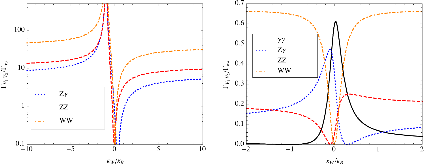Implications of Gauge Invariance on a Heavy Diphoton Resonance
Abstract
Assuming a heavy electroweak singlet scalar, which couples to the Standard Model gauge bosons only through loop-induced couplings, SU(2)_L x U(1)_Y gauge invariance imposes interesting patterns on its decays into electroweak gauge bosons, which are dictated by only two free parameters. Therefore experimental measurements on any two of the four possible electroweak channels would determine the remaining two decay channels completely. Furthermore, searches in the WW/ZZ channels probe a complimentary region of parameter space from searches in the gamma-gamma/Z-gamma channels. We derive a model-independent upper bound on the branching fraction in each decay channel, which for the diphoton channel turns out to be about 61%. Including the coupling to gluons, the upper bound on the diphoton branching fraction implies an upper bound on the mass scale of additional colored particles mediating the gluon-fusion production. Using an event rate of about 5 fb for the reported 750 GeV diphoton excess, we find the new colored particle must be lighter than O(1.7 TeV) and O(2.6 TeV) for a pure CP-even and a pure CP-odd singlet scalar, respectively.
- Authors:
-
- Northwestern U.
- Fermilab
- Publication Date:
- Research Org.:
- Argonne National Lab. (ANL), Argonne, IL (United States); Fermi National Accelerator Lab. (FNAL), Batavia, IL (United States)
- Sponsoring Org.:
- USDOE Office of Science (SC), High Energy Physics (HEP)
- OSTI Identifier:
- 1288735
- Report Number(s):
- FERMILAB-PUB-15-583-T; arXiv:1512.09089
1411697
- DOE Contract Number:
- AC02-07CH11359
- Resource Type:
- Journal Article
- Country of Publication:
- United States
- Language:
- English
- Subject:
- 72 PHYSICS OF ELEMENTARY PARTICLES AND FIELDS
Citation Formats
Low, Ian, and Lykken, Joseph. Implications of Gauge Invariance on a Heavy Diphoton Resonance. United States: N. p., 2015.
Web.
Low, Ian, & Lykken, Joseph. Implications of Gauge Invariance on a Heavy Diphoton Resonance. United States.
Low, Ian, and Lykken, Joseph. 2015.
"Implications of Gauge Invariance on a Heavy Diphoton Resonance". United States. https://www.osti.gov/servlets/purl/1288735.
@article{osti_1288735,
title = {Implications of Gauge Invariance on a Heavy Diphoton Resonance},
author = {Low, Ian and Lykken, Joseph},
abstractNote = {Assuming a heavy electroweak singlet scalar, which couples to the Standard Model gauge bosons only through loop-induced couplings, SU(2)_L x U(1)_Y gauge invariance imposes interesting patterns on its decays into electroweak gauge bosons, which are dictated by only two free parameters. Therefore experimental measurements on any two of the four possible electroweak channels would determine the remaining two decay channels completely. Furthermore, searches in the WW/ZZ channels probe a complimentary region of parameter space from searches in the gamma-gamma/Z-gamma channels. We derive a model-independent upper bound on the branching fraction in each decay channel, which for the diphoton channel turns out to be about 61%. Including the coupling to gluons, the upper bound on the diphoton branching fraction implies an upper bound on the mass scale of additional colored particles mediating the gluon-fusion production. Using an event rate of about 5 fb for the reported 750 GeV diphoton excess, we find the new colored particle must be lighter than O(1.7 TeV) and O(2.6 TeV) for a pure CP-even and a pure CP-odd singlet scalar, respectively.},
doi = {},
url = {https://www.osti.gov/biblio/1288735},
journal = {},
number = ,
volume = ,
place = {United States},
year = {Wed Dec 30 00:00:00 EST 2015},
month = {Wed Dec 30 00:00:00 EST 2015}
}
Figures / Tables:
 FIG. 1: Left: Partial widths in WW , ZZ and Zγ, normalized to Γγγ , as a function of κW /κB . Experimental input from one channel then determines the partial widths in the other two channels. Right: The upper bound of BR(V1V2) as a function of κW /κB, whichmore »
FIG. 1: Left: Partial widths in WW , ZZ and Zγ, normalized to Γγγ , as a function of κW /κB . Experimental input from one channel then determines the partial widths in the other two channels. Right: The upper bound of BR(V1V2) as a function of κW /κB, whichmore »